
The LONDON TRANSPORT Leyland CR
This page created 3rd April 2000, updated 2nd August 2023 using Notepad, by Ian Smith.

Introduction
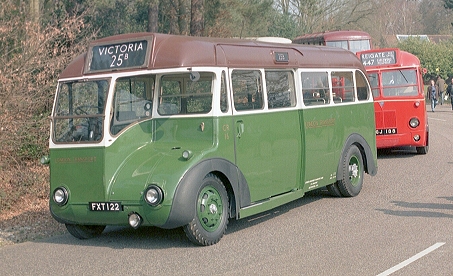 The Rear engined Cubs were born out of their time.
The concept was much the same as for the Dennis Dart that followed fifty years later:
small compact bus, rear-engined with one person operation capability.
They were in a strong line of bus development being pursued by the single deck bus designers of London Transport.
There had been the revolutionary AEC Q's, earlier in the thirties,
with offside counter-rotating engine.
There had been the elegant TF coaches,
Leyland Tigers with engines flat under the floor.
The Rear engined Cubs were born out of their time.
The concept was much the same as for the Dennis Dart that followed fifty years later:
small compact bus, rear-engined with one person operation capability.
They were in a strong line of bus development being pursued by the single deck bus designers of London Transport.
There had been the revolutionary AEC Q's, earlier in the thirties,
with offside counter-rotating engine.
There had been the elegant TF coaches,
Leyland Tigers with engines flat under the floor.
So when LT came up with a requirement for more small buses to replace the remaining Dennis Darts (DA class)
and small Bedfords (BD),
the designers produced the Cub Rear rather than ordering more
C class Leyland Cubs.
The prototype, CR1
CR1 was built in 1937, the chassis being delivered to Chiswick in October 1937
and the Chiswick-built body fitted right at the end of December. It was licensed at the beginning of January 1938,
and shown off to officials and press in Westminster.
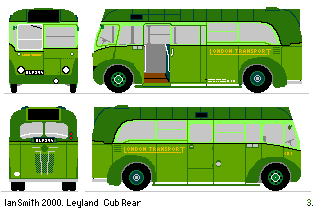 The driving position was right forward, with a half-cab, with a sliding door behind the front wheels.
The 4.4 litre engine was mounted longitudinally on the centre of the rear overhang,
and drove forward to a gearbox, then down backwards through the final drive unit to the de Dion rear axle.
The driving position was right forward, with a half-cab, with a sliding door behind the front wheels.
The 4.4 litre engine was mounted longitudinally on the centre of the rear overhang,
and drove forward to a gearbox, then down backwards through the final drive unit to the de Dion rear axle.
The 20 seater body had an outside-sliding main door, an offside emergency door, and no separate driver's door.
It was finished in a livery of three shades of green. (I can find no clear picture of the nearside, so originally thought that the door was internal.)
Although the press photos showed it with Watford (WT) running plates and 355 route displays,
the new bus was allocated to St Albans (SA). It ran there for a while,
then moved in March 1939 to Windsor where it operated alongside odd Cub C76.
The new bus was not without its teething troubles: it ran quietly, except for raucous gear changes.
It was liked by passengers, but much less so the staff:
the drivers complained that passengers did not notice that they had to go to him at the front of the bus for tickets,
so they frequently had to leave their seat to go back to see them. Even when passengers did go to the driver to pay, they had to turn left to him to pay, then work back past other boarders.
The driver had to turn right round in his seat to issue tickets and receive payment.
The gear changes, with the quiet engine and gear-box at the bus rear, could not be heard by the driver,
so were often clashes, with accompanying jerks. CR1 had to return to works often for remediation, including a trip to Leyland in Lancashire. Its fuel consumption was very variable, and generally too high.
It was overhauled in November 1939 and received Lincoln green and white livery, with white patches and white spot on the rear.
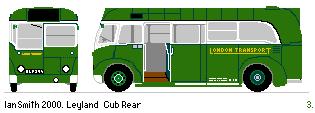 Like the other CRs, it was withdrawn during the war and placed in store,
re-emerging in 1946 to play a role as a Central Area spare, based at Streatham (AK),
where it continued to wear its green and white whilst working on rush-hour extras with conductors on routes such as the 133.
It was scrapped by LT in 1949.
Like the other CRs, it was withdrawn during the war and placed in store,
re-emerging in 1946 to play a role as a Central Area spare, based at Streatham (AK),
where it continued to wear its green and white whilst working on rush-hour extras with conductors on routes such as the 133.
It was scrapped by LT in 1949.

Production buses: CR2-49
An order for 48 production CRs followed even before CR1 entered service. There had been an intention to order 74,
but there were only 41 DAs and 12 BDs to replace.
Only 134 small buses were needed in total,
and there were 76 normal-control Cubs, so the order had been cut to 59.
Further reductions in requirement, with larger saloons taking over small-bus work
reduced the number to 48 eventually ordered and built.
The production buses were not identical to CR1. They had a larger 4.7litre engine,
and the bodywork was redesigned to give a level window-line,
with the main door moved forward to improve access to the driver for single person operation.
The fairing behind the front nearside wheel was continued on the sliding door.
Seating and interior trim was the standard familiar for many years after the war to users of RTs, RFs and GSs.
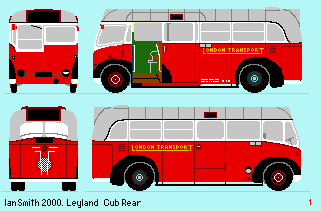 The Central area buses were delivered in red, with white window surrounds, black mudguards and a black roof.
The latter was repainted matt grey before entry into service because of the air raid precautions coming into force.
The first, CR2 emerged just after the declaration of war, on 8th September 1939.
White trims and masked lamps emphasised the war treatment. The grey roofs were soon deemed to be too light,
and were replaced by a covering of red oxide or brown. Traces of the original black roof could be seen around the rear window and the display boxes.
The Central area buses were delivered in red, with white window surrounds, black mudguards and a black roof.
The latter was repainted matt grey before entry into service because of the air raid precautions coming into force.
The first, CR2 emerged just after the declaration of war, on 8th September 1939.
White trims and masked lamps emphasised the war treatment. The grey roofs were soon deemed to be too light,
and were replaced by a covering of red oxide or brown. Traces of the original black roof could be seen around the rear window and the display boxes.
They went into service from September 1939 at a variety of garages:
- (Sept-Nov39) Kingston received the first eleven, CR2-11 plus 19, for the 216 and 206, replacing DAs.
- (Nov39) Windsor gained CR12-17 in green/white/brown, replacing, ultimately, BDs
- (Nov39) Hounslow used CR19 and 20-27 to displace tiny DA Darts from the 237.
- (Nov39) Uxbridge used CR28-34 on the 220, 223 and 224.
- (Dec39) Enfield had CR35 for the 205 and 205A, joined by CR11 from K
- (Feb40) Harrow Weald used CR49 on the 221
| Date | Garage | Route | Route |
|---|
| 9/39 | K Kingston | 216 | Kingston - Hampton - Sunbury - Ashford - Staines |
| 9/39 | K Kingston | 206 | Esher (Windsor Arms) - Claygate (The Causeway) |
| 11/39 | WR Windsor | 442 | Slough - Stoke Poges - Farnham Royal |
| 11/39 | WR Windsor | 462 | Leatherhead (Plough) - Cobham - (Redhill Road) - Vickers Works - Weybridge - Addlestone - Chertsey - Staines - Slough |
| 11/39 | WR Windsor | 461 | Hersham Green - Walton-on-Thames - Addlestone - Chertsey - Staines (-Datchet-Slough) (one journey) |
| 11/39 | AV (Hounslow) | 237 | Hounslow Garage - Hounslow Heath - Feltham - Sunbury - Sunbury Village - Shepperton - Chertsey Stn |
| 11/39 | UX (Uxbridge) | 220 | Pinner (Red Lion) - Eastcote - Ruislip - Ickenham - Hillingdon - Uxbridge Stn |
| 11/39 | UX (Uxbridge) | 223 | West Drayton Stn - Uxbridge - Ickenham - Ruislip Stn |
| 11/39 | UX (Uxbridge) | 224 | Stanwell - Staines - Wraysbury - Colnbrook - Longford - Harmondsworth - West Drayon - Cowley - Uxbridge Stn |
| 12/39 | E (Enfield) | 205 | Potters |Bar Garage - Northaw - Cuffley - Cheshunt - Waltham Cross - Waltham Abbey - Chingford (RFH) |
| 12/39 | E (Enfield) | 221 | Hammond Street (Rising Sun) - Flamstead End - Cheshunt - Waltham Cross |
| 2/40 | HD (Harrow Weald) | 205A | North Harrow Stn - Headstone Lane - Hatch End - Pinner (Red Lion) |
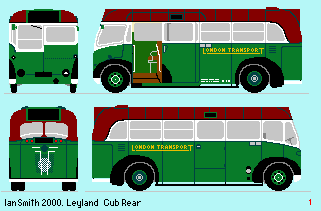
The Country area took six (CR12-17), painted green, white and brown from new,
and sent them to Windsor to join CR1. They were used on the 442, 462 and a 461 journey.
They too were placed in store - at Windsor - from November 1940 or May 1941, as aircraft production at Weybridge and Cobham required much more capacity.
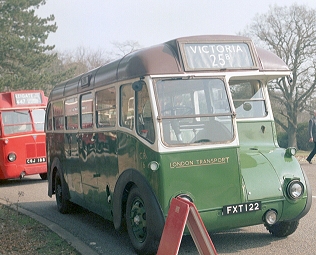
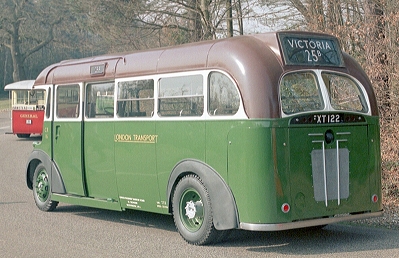
War-time doldrums
Not all were used: the demands on labour meant that twenty-seater buses were deemed over-indulgent, the cutback in private transport produced demands for bigger buses, and war manufacturing meant greater work-forces.
So CR36 and CR38-46 went straight from delivery into storage,
and others rotated between use and storage for a while, some going to Kingston, Uxbridge and Hounslow as extras, to be used if needed.
Non-passenger uses were found for some of them. CR6 (from Kingston), CR38 and CR41 were allocated for use by the Paymaster, and were housed at Mortlake.
CR6 then had its seats removed and became a lorry for the Chiswick Stores Department. Similarly bereft of seats, CR42 was used as a lorry by London Aircraft Production at Chiswick.
CR36,40 and 45 were also used by Chiswick Works during 1940 and 1941.
Those allocated to garages when new were mostly superceded by larger types. The Enfield pair were replaced by T-type Regals in September 1940.
The Windsor buses had all been replaced by May 1941. Uxbridge replaced its CR allocations with T-types and more reliable Cubs in spring 1942.
Hounslow's 237, which had a mixture of Cs and CR37 and 49, lost these two in July 1942. 33 CRs were gathered together into store at Forest Road in Walthamstow, the old AEC works.
Presumably no-one much worried that they would be extingushed there by bombing of the East End. But that fate had befallen CR18, bombed to oblivion at Bull Yard in Peckham in September 1940.
There they stayed.
Brief postwar resurrection
Even by 1946 there was not really a role for them.
The Central Area had abandoned one person operation, and small saloons in general.
The Cubs had congregated in the Country Area, but even there found too little work.
The pressure was on for large buses, to shift the crowds to and from work.
Not yet was there scope for route development using small buses initially.
But the shortage of buses was becoming desperate, and LT could not hire buses while its own were sitting in store.
So the rear engined Cubs came out of store during 1946,
and went to work (CR44 for the first time) at a number of Central Area garages, including Athol Street (Poplar), Chalk Farm, Cricklewood, Croydon, Tottenham, Putney Bridge, Merton and Streatham.
It was not what they were designed for, but rush hour relief work,
with conductors, operating into London and Westminster in many cases.
They also acted as spares, replacing much larger vehicles as those suffered Ministry compulsory withdrawals.
Still a strange new design, they were overloaded, crowded,
and not surprisingly suffered breakdowns.
Even the six green CR2s, plus CR1, were pressed into Central Area service, from Streatham,
from which garage they ventured forth to Liverpool Street Station om the 133, looking very scruffy in thei faded green and white,
with roofs that had lost much of their brown oxide leaving a scruffy mess of original grey.
But nine had been repainted into fresh red and white, with renewed brown-painted roof.
These had been smoke-damaged by a fire at a neighbouring factory in Forest Road, and needed a repaint to be useable.
1948 produced a niche for them to occupy. In July and August London hosted the Olympic Games,
and these small buses were useful to transfer teams and officials to and from Wembley and other venues.
Twenty-four CRs were pulled from their peak-busting activities and allocated to Cricklewood, Hounslow, Putney and Putney Bridge for the duration,
in most cases returning whence they came after the event. A steady stream of them passed through Chiswick Works for overhaul, some changing colour in the process.
A pair at Hornchurch were put back to regular use on the 238 and 252.
The Central Area buses were once more placed into store en masse in May and June 1949, when the flood of new RTs eased the Central Area situation.
Twenty-seaters were no longer required as peak-hour extras. The little buses went into store at Slough and Reigate.
New routes in the Country Area
A handful of the Central Area buses were repainted into green and white at this time, and transferred to the Country Area, where there were still niches for them to occupy,
and where single-man operation was still common. The original idea, to use them for new routes around the fringes of burgeoning suburbia was now to see fresh opportunitis.
In October 1948 a pair, CR14 and CR16, were allocated to East Grinstead for use on new route 494, linking villages between Oxted and East Grinstead.
CR14, red, was quickly repainted green at overhaul in February 1949. November 1948 saw red CR5 arrive at Chelsham for use on the 464,465, 485 triangle, bolstering the Cub population there.
Green CR13 and CR19 arrived at Chelsham in spring 1949 for these hard-worked routes.
But it was not to last. The four in the Country Area were withdrawn to store at Reigate in July 1949, when the last of the Central Area CRs also succumbed.
Two years passed before the next flurry of Country Area activity. Many of the ordinary Cubs had been sold, and the new GS class had not yet appeared, but Country Area demnd was growing.
In September 1951 red CR4 and red CR43 were allocated to Epping for routes 381 and 393. They were joined the following month by CR10.
Meanwhile CR13 and CR14 went to East Grinstead for another spell on the 494. When CR10 left Epping in June 1942 it went to Tring for the short 387, soon joined by CR17.
| Date | Garage | Route | Route |
|---|
| 10/48 | EG East Grinstead | 494 | East Grinstead - Lingfield - Crowhurst Place - Chathill - Tandridge - Old Oxted - Oxted Station |
| 11/49 | CM Chelsham | 464
465
485 | Holland - Old Oxted - Oxted Stn - Chart - Hosey Common - Westerham
Holland - Old Oxted - Oxted Stn - Chart - Crockham Hill - Edenbridge
Westerham- Hosey Common - Crockham Hill - Hilders Lane - Edenbridge |
| 9/51 | EP Epping | 381 | Harlow - Tylers Cross - Epping Green - Beaconfield Estate - Epping - Epping Stn - Coopersale Common - Colliers Hatch - Toot Hill |
| 9/51 | EP Epping | 393 | Harlow - Tylers Cross - Nazeingbury - Broxbourne |
| 5/53 | LH Leatherhead | 481 | Epsom - Wells Estate |
| 7/53 | TG Tring | 387 | Tring LT Garage - Tring Stn - Aldbury |
But a further surprise came in May 1953 when CR43, which had been reinstated back in September 1951 for use at Epping on the 381 in Central Area livery, was repainted into Country Area green/white and sent to Leatherhead for the 481 "swinger" (Epsom Station to Wells Estate). There it was joined by long-term green companion CR13 from East Grinstead, where it had been the 494 steed for some years.
Then in July 1953 CR4, which had previously been reinstated for the 393 at Epping, was taken back out of store at Reigate and sent to join CR17 at Tring for the 387 (Tring LT Garage- Aldbury).
By 1953 most were withdrawn, mostly for sale to L.W.Vass of Ampthill, or W.North in Leeds, where they were variously sold on or scrapped.
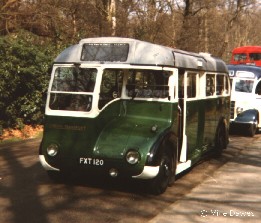 These lasted until the end of 1953,
when the new GS
class put paid to the last few.
These lasted until the end of 1953,
when the new GS
class put paid to the last few.
Preservation
One, CR14, was collected by the LT Museum for preservation,
but was sold in 1967 for private preservation.
It has since been seen occasionally in public.
Several others were exported to Cyprus,
whence two have been repatriated with restoration and preservation in mind.
CR36 is little more than a chassis.
CR16 has been substantially rebuilt, and reappeared in Country green and white livery at the Cobham Bus Gathering in April 2007. It seems to have taken up residence in the London Bus Museum at Brooklands.
Preserved CR14 on an outing. Photo, used by permission, by Mike Dawes.
For a deeper analysis, and readable history of the CR class, read Ken Blacker's "Londons Pre-War Smaller Classes".

 Ian's Bus Stop Ian's Bus Stop
 CR main text. CR main text.
 CR histories CR histories
 CR photo refs CR photo refs

|

 The Rear engined Cubs were born out of their time.
The concept was much the same as for the Dennis Dart that followed fifty years later:
small compact bus, rear-engined with one person operation capability.
They were in a strong line of bus development being pursued by the single deck bus designers of London Transport.
There had been the revolutionary AEC Q's, earlier in the thirties,
with offside counter-rotating engine.
There had been the elegant TF coaches,
Leyland Tigers with engines flat under the floor.
The Rear engined Cubs were born out of their time.
The concept was much the same as for the Dennis Dart that followed fifty years later:
small compact bus, rear-engined with one person operation capability.
They were in a strong line of bus development being pursued by the single deck bus designers of London Transport.
There had been the revolutionary AEC Q's, earlier in the thirties,
with offside counter-rotating engine.
There had been the elegant TF coaches,
Leyland Tigers with engines flat under the floor.
 The driving position was right forward, with a half-cab, with a sliding door behind the front wheels.
The 4.4 litre engine was mounted longitudinally on the centre of the rear overhang,
and drove forward to a gearbox, then down backwards through the final drive unit to the de Dion rear axle.
The driving position was right forward, with a half-cab, with a sliding door behind the front wheels.
The 4.4 litre engine was mounted longitudinally on the centre of the rear overhang,
and drove forward to a gearbox, then down backwards through the final drive unit to the de Dion rear axle.
 Like the other CRs, it was withdrawn during the war and placed in store,
re-emerging in 1946 to play a role as a Central Area spare, based at Streatham (AK),
where it continued to wear its green and white whilst working on rush-hour extras with conductors on routes such as the 133.
It was scrapped by LT in 1949.
Like the other CRs, it was withdrawn during the war and placed in store,
re-emerging in 1946 to play a role as a Central Area spare, based at Streatham (AK),
where it continued to wear its green and white whilst working on rush-hour extras with conductors on routes such as the 133.
It was scrapped by LT in 1949.
 The Central area buses were delivered in red, with white window surrounds, black mudguards and a black roof.
The latter was repainted matt grey before entry into service because of the air raid precautions coming into force.
The first, CR2 emerged just after the declaration of war, on 8th September 1939.
White trims and masked lamps emphasised the war treatment. The grey roofs were soon deemed to be too light,
and were replaced by a covering of red oxide or brown. Traces of the original black roof could be seen around the rear window and the display boxes.
The Central area buses were delivered in red, with white window surrounds, black mudguards and a black roof.
The latter was repainted matt grey before entry into service because of the air raid precautions coming into force.
The first, CR2 emerged just after the declaration of war, on 8th September 1939.
White trims and masked lamps emphasised the war treatment. The grey roofs were soon deemed to be too light,
and were replaced by a covering of red oxide or brown. Traces of the original black roof could be seen around the rear window and the display boxes.




 Ian's Bus Stop
Ian's Bus Stop CR main text.
CR main text. CR histories
CR histories